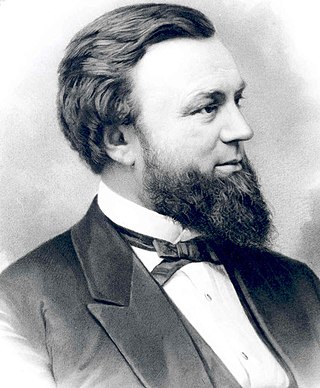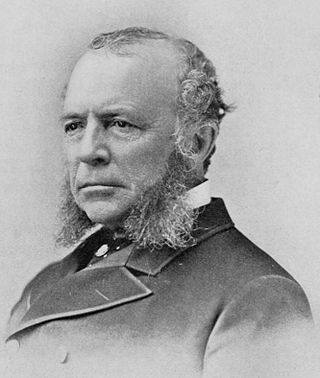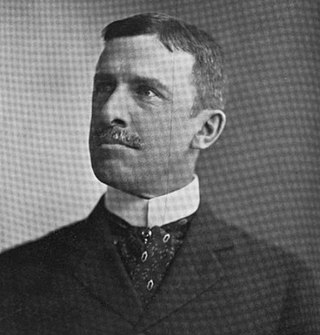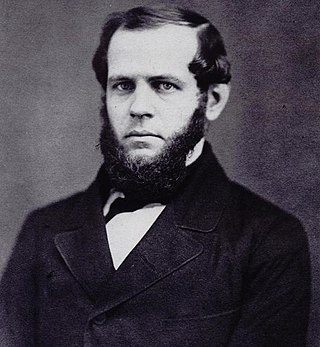
Frederick H. Billings was an American lawyer, financier, and politician. He is best known for his legal work on land claims during the early years of California's statehood and his presidency of the Northern Pacific Railway from 1879 to 1881.

Edward John Phelps was a lawyer and diplomat from Vermont. He is notable for his service as Envoy to Court of St. James's from 1885 to 1889. In addition, Phelps was a founder of the American Bar Association, and served as its president from 1880 to 1881.

Edward Curtis Smith was an American attorney, businessman, and politician from Vermont. A Republican, he was most notable for his service as the 47th governor of Vermont from 1898 to 1900.

Peter Thacher Washburn was a Vermont lawyer, politician and soldier. A veteran of the American Civil War, he served as the 31st governor of Vermont as a Republican from 1869 to 1870, and was the first Vermont Governor to die in office.

Ebenezer Jolls Ormsbee, the 41st governor of Vermont, was a Republican Party politician, a teacher, a lawyer and an American Civil War veteran.

William Wallace Grout was an American politician and lawyer. He served as a U.S. Representative from Vermont.

John Boardman Page was an American businessman and politician from Vermont. He served as Vermont State Treasurer from 1860 to 1866 and was the 30th governor of Vermont from 1867 to 1869.

John Calvin Coolidge Sr. was an American politician and businessman from Vermont, and the father of Calvin Coolidge, the 30th president of the United States. The senior Coolidge administered the presidential oath of office to his son at their family homestead in the early morning hours of August 3, 1923, following the death of President Warren G. Harding.

Levi Underwood was a lawyer and politician from Vermont. Originally a Democrat, Underwood's antislavery views caused him to join the new Republican Party when it was founded. Underwood was most notable for his service as the 23rd lieutenant governor of Vermont from 1860 to 1862.

Lambert Packard (1832-1906) was an American architect from St. Johnsbury, Vermont.

Gurdon P. Randall was an architect in Chicago, Illinois. Early in his career, he studied in Boston, Massachusetts, in the office of Asher Benjamin. He moved to Chicago when he was 30, and practiced there for 34 years, focusing on large institutional architecture. He designed a number of notable buildings, including several that survive and are listed on the National Register of Historic Places.

Frank Lyman Austin (1874-1942) was an American architect from Burlington, Vermont. He designed several buildings that have been placed on the National Register of Historic Places and others that are contributing buildings to listed historic districts.

George H. Guernsey was an American architect from Montpelier, Vermont.

Arthur H. Smith was an English-American architect who practiced in the small city of Rutland, Vermont.
Clinton Smith was an American architect. He designed many buildings in Middlebury and around Vermont.

Charles Linsley was a Vermont lawyer and politician. The son-in-law of Daniel Chipman, he was notable for his service as United States Attorney for the District of Vermont (1845-1849), member of the Vermont House of Representatives (1858-1859), and U.S. Collector of Customs for Vermont (1860-1861).
George W. Barker was an American businessman and public official in Vermont and Wisconsin. He was notable for his service as United States Marshal for the District of Vermont (1835-1837), Sheriff of Washington County, Vermont (1843-1845), and Judge of Manitowoc County, Wisconsin (1864-1869).
Charles Chapin was a physician and public official from Brattleboro, Vermont. Among the offices in which he served were member of the Vermont House of Representatives (1833-1834) and United States Marshal for the District of Vermont (1853-1857).
Charles C. P. Baldwin was a government official in Vermont. A Republican, prior to becoming a resident of Iowa in his later years, he served as Sheriff of Orange County, Vermont and United States Marshal for the District of Vermont.

Francis V. Randall was an attorney, farmer, college administrator, and military officer from Vermont. A Union Army veteran of the American Civil War, he was most notable for his service as commander of the 13th Vermont Infantry Regiment during the war and his post-war appointment as vice president of Norwich University.






















